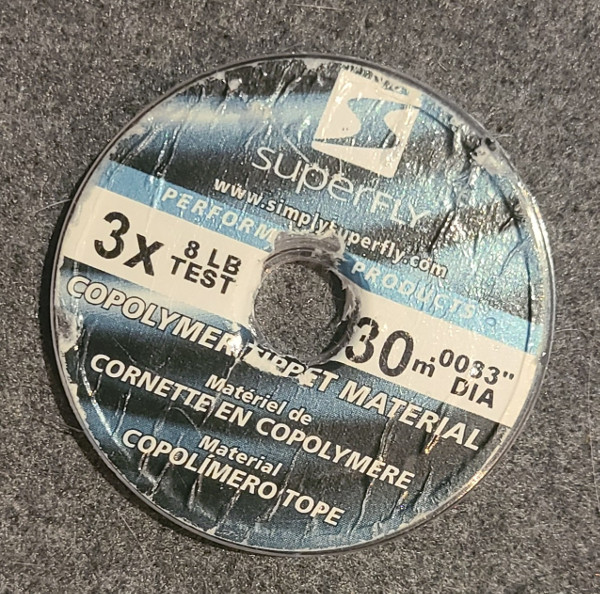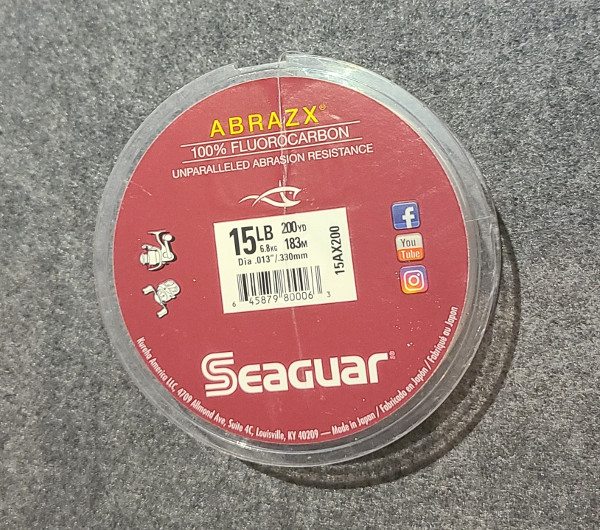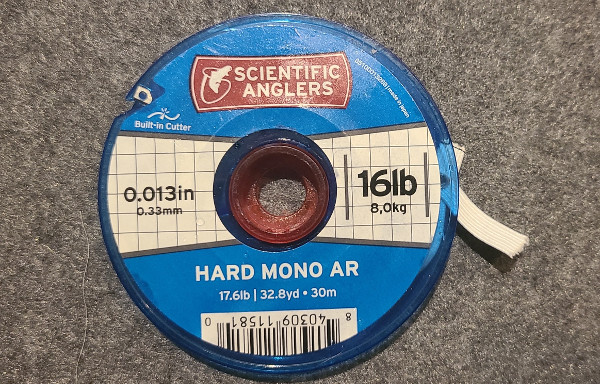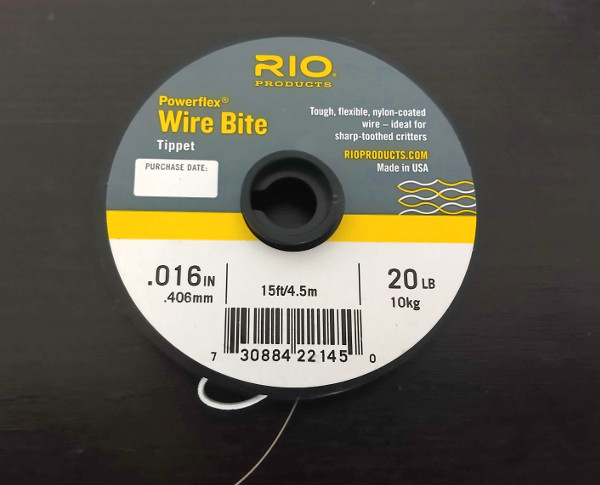What is the difference between a leader and tippet in fly fishing? While they are quite similar, they are two distinct components of your fly fishing setup. Let’s clarify exactly what a leader is, what tippet is, and the difference between the two.
What is a Leader in Fly Fishing?
A leader is the section of line between your fly line and tippet. Most leaders are made of monofilament, with a taper that is thicker at the butt end and gets thinner towards the tippet/fly. This taper aids in turning over the fly while casting.
A tapered leader isn’t always necessary, especially when throwing larger flies on bigger rods. A straight piece of mono or fluoro as a leader is not uncommon for anglers throwing heavy streamers.
So why can’t you tie a fly directly to the leader? Well, you can actually. For several reasons (which I discuss below), most fly anglers choose to have a length of tippet to tie the fly on instead.
What is Fly Fishing Tippet?
Tippet is the section of line between the leader and the fly. The primary purpose of the tippet is to give the angler additional line length to preserve the leader. Without tippet, you would be reducing your leader length every time you change flies. This is an especially important consideration with a tapered leader, as you would change the taper as you shorten the leader.
Tippet choice is more than just giving an extra length of line. Tippet makes up the last section of the line before the fly. This brings up a few considerations when choosing the right tippetf for any given angling situation.
- Are the trout spooky, or in high pressured water? A tippet with low visibility and/or diameter is ideal.
- Are you fishing around sharp surfaces such as rocks? If so, an abrasion-resistant tippet should be taken into consideration.
- Are you targeting toothy critters (pike). Bite-proof tippet is highly recommended (such as wire or heavy fluoro).
- Are you targeting non-toothy fish (trout, bass), but toothy critters are likely as bycatch? Then consider a bite-resistant or extremely abrasive resistant tippet to reduce the likelihood of a pike biting through your tippet and swimming off with your fly.
Should I be using Monofilament or Flouro Carbon for my leaders and tippet?
Monofilament

This has been used for many years and is the traditional material for both fly fishing leaders and tippet. Most leaders on the market for fly fishing are made of monofilament.
What is Monofilament? It’s a single-strand material that is (typically) made of nylon. By combining different types of nylon together in differing amounts, fishing ling manufacturers are able to produce monofilament with varying properties.
Advantages
- Generally cheaper.
- Floats. Ideal for dries and topwater
- Weighted flies or sinking fly lines will have no problem bringing mono below the surface though.
- Less memory than Flouro. Mono is much less prone to the annoying coiling behavior that is present in many fluorocarbon lines.
- Generally stronger knots. Since mono is fairly soft, it “seats” well when a knot is pulled tight.
- Mono will stretch about 10%. When a big trout slams your fly, the mono acts as a shock tippet. This gives the anglers some extra play in their line before a fish is able to break them off.
I’ll use mono for most dry fly and topwater fly fishing. I also often use it for nymphing with an indicator, as the extra sensitivity given from flouro isn’t necessary when you have a visual cue that a trout has taken your nymph pattern.
Scientific Anglers Nylon Mono Tippet (Amazon Link)
Fluorocarbon

There are many different types of fluorocarbon on the market. Some fluoro lines are specifically designed around one benefit more than the other. In general , fluorocarbon lines have the following advantages
Advantages
- Transparency. Flouro actually refracts light at the same wavelengths that water does. This means that flour is essentially invisible underwater, making it the perfect line for wary, timid, or high pressured fish.
- Abrasion resistance. Another major advantage of fluorocarbon lines is that they hold up much better to rocks, metal, coral, and other sharp surfaces. If you’re fishing alone the bottom, or near structure likely to nick your line, then fluoro will last much longer than most monolines.
- Bite resistance. Closely related to abrasion resistance. There are some fluoro lines that take abrasion resistance to the point of being an effective bite guard. I personally use seaguar line when bass fishing, as small pike are common as bycatch. I very rarely have a pike bike through this line.
- Less buoyant. Flouro is slightly less buoyant than mono, making it a great choice for nymphs and streamers. Line diameter still plays a huge role in sink rate though. Thinner lines will sink faster.
- Flouro can still be used to fish dries and topwater flies. The sink rate is negligible, and most lightweight fluoro lines will not break the water tension without a weighted fly or sinking line.
- While fluoro still has a bit of stretch, is much less than monofilament. The lack of stretch makes this line much more sensitive to strikes. This is an ideal property to have in a line if you’re trying to detect subtle strikes by feel alone (E.G. Euro nymphing). It’s a trade-off between having a bit of stretch to act as a shock tippet, and having little stretch to help in strike detection.
- It’s worth noting that some flouro will stretch initially and not rebound. Simply stretch the line once tied to remove this initial stretch. This will increase the sensitivity of your flourocarbon leader.
- The lack of stretch also helps drive hooksets home. Can be particularly useful on fish that a strip hook set is necessary instead of the standard trout hook set.
Fluorocarbon is my go-to for most streamer fishing. I’m a bit of a streamer nut, and fishing streamers much more often than I do dries or nymphs. This means that I use fluorocarbon leaders quite often.
I’ll also use fluorocarbon when high stick or euro nymphing for the increased sensitivity.
Rio Fluoroflex Strong Fluorocarbon Tippet 3 (Amazon Link)
Other Options
Mono and Flouro are the two main considerations when choosing fly fishing leaders and tippet. There are a few other options though.
Hard Monofilament

You don’t see this very commonly in fly fishing circles. When you do see it, it’s typically in regards to saltwater fly fishing. It has applications for freshwater fly fishing as well though.
Hard mono has the advantages of mono in that it floats. It also has some of the traits of flouro, such as being abrasion/bite-resistant. This combination of factors makes hard mono an ideal choice in a specific set of fishing circumstances.
I use hard mono when fishing poppers for smallmouth bass in water with pike present. This reduces the number of bite-offs from smaller pikes grabbing the gurgler meant for smallmouth bass, without me needing to resort to wire bite tippet that may reduce the number of strikes due to its noticeable visibility.
Rio Fly Fishing Tippet Hard Mono 16Lb (Amazon Link) is a hard mono that I’ve used with much success. Alternatively, Scientific Anglers make a good hard mono tippet as well (pictured above) You can go down to an 8lb tippet strength if you like and still retain some level of bite resistance, although I typically stay around the 16lb mark.
Wire bite tippet

You would never have a whole leader made of wire, but a wire bite tippet is an important consideration when fly fishing for toothy fish such as pike and musky. These fish are apex predators and generally are not as line shy as other species traditionally targeted on the fly such as salmon and trout.
I use wire bite tippet when specifically targeting pike and musky. My preferred brand of wire bite tippet is Rio Fly Fishing Tippet Powerflex Wire Bite Tippet (Amazon Link)

2 thoughts on “Mono or Flouro: Choosing the Right Fly Fishing Leader and Tippet”